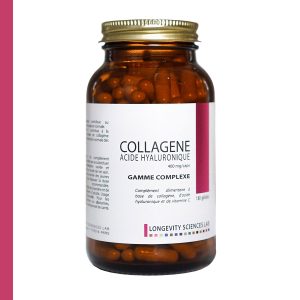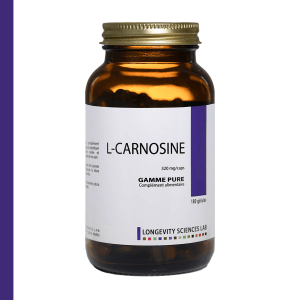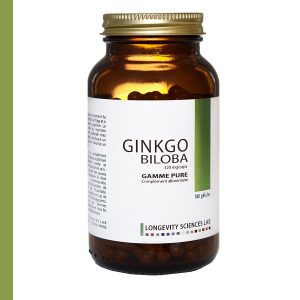Description
RED RICE YEAST is a popular dietary supplement that has been used for centuries in traditional Chinese medicine to reduce cholesterol and improve blood circulation.
Here are the properties described in the scientific literature:
- Regulation of cholesterol levels
- Cardioprotective effects
- Antioxidant and anti-inflammatory actions
- Improvement of digestion
Why choose our product to support your health?
Our products are manufactured in the heart of the Loire Valley in France.
Through our partner laboratories, all our products are certified organic.
Exclusively composed of natural ingredients, our product is guaranteed free of additives and GMOs.
The formulation of our products has been studied with the utmost expertise to allow optimal action of our physiological correctors for your well-being.
By following the recommended dosage, our physiological corrector will cost you €18.50 per month.
Invest in your health with Longevity Sciences Lab.
CRITICAL ANALYSIS OF RED YEAST RICE SCIENTIFIC LITERATURE
Red rice yeast reduces cholesterol with minimal secondary effects
A regular red rice yeast intake allows to regulate cholesterol levels by diminishing the total cholesterol rate and specifically LDL cholesterol (the cholesterol prone to be deposited on the artery walls). Cholesterol is a lipid mainly produced by the liver and intestine cells. It is necessary among other things to steroid hormone synthesis and to bile synthesis while being a major component of cell membrane. High cholesterol levels increase the risk of heart conditions by the formation of atherosclerosis plaques. Indeed, cholesterol deposit accumulation on the internal wall of the arteries fosters a gradual diameter shrinkage and increases the risk of heart attacks, strokes, or cardiovascular diseases.
Red rice yeast is frequently used to reduce cholesterol rates and therefore to promote cardiac health. This yeast has less adverse secondary effects than the allopathic prescriptive drugs used to treat hypercholesterolemia, as was demonstrated by the researchers of the cardiology department of the Children’s Hospital of Wenzhou in China. Indeed, statins are allopathic drugs given in case of hypercholesterolemia to inhibit cholesterol production. Those molecules are known for their adverse effects, mainly provoking pain in muscles and tendons. A study of a group of 60 dyslipidemic patients presenting low cardiovascular risks were recruited and randomly allocated. A group received simvastatin and another red rice yeast for 4 weeks. The muscular-fatigue-score and physical activity was later evaluated. The study results show that the fatigue score significantly increased in patients treated with simvastatin whereas no change was observed in patients receiving red rice yeast. Furthermore, physical activity capacity was considerably diminished in patients treated by simvastatin compared to those in the red rice yeast group (1).
Other studies revealed that red rice yeast was effective in reducing overall cholesterol levels, especially in the case of LDL cholesterol. Moreover, red rice yeast improves artery flexibility and enables to prevent cardiac diseases (2).
For more information, another study examined the effects of red rice yeast on mice fed with a high-fat diet compared to another control group. This revealed that red rice yeast allowed to inhibit mice weight-gain and diminished blood lipid levels. Thus, that confers to red rice yeast an anti-obesity effect (3). This efficiency is directly linked to the quantity of monacolin K, stemming from the red rice yeast extract (up to 10 mg/day). According to a study led at the University of Bologna in 2019, daily consumption of monacolin K reduces the plasma levels of low-density lipoprotein cholesterol (LDL) by 15 to 25% in 6 to 8 weeks. In addition, the cholesterol-lowering effects of red rice yeast is associated with significant improvement of the speed of pulse waves and of the endothelial function (internal layer of blood vessels). These two biomarkers are reliable to detect vascular aging. Even though it acts in a similar way to statins, a daily consumption of 3 to 10 mg of monacolin K, found in red rice yeast, is only associated with minimal risks. Moreover, the light muscular disorders are only observed in the most fragile ones (those who neither cope with minimal statin doses). Thus, Monacolin K, found in red rice yeast, is a reliable and efficient complement to handle light to moderate hypercholesterolemia without generating additional cardiovascular risks (4).
Red rice yeast enables coronary disease prevention
The prospective clinical results of a 2008 study conducted by the Chinese Medical Science Academy of Beijing showed the efficiency of lipid-lowering drugs in the reduction of cardiovascular events. To do this, the study examined the effects of red rice yeast on lipoproteins (the cholesterol carriers) and cardiovascular parameters on Chinese patients with a previous myocardial infarction. Around 5000 of these patients, presenting medium LDL levels, were randomly assigned to a placebo or to red rice yeast over the average course of 4 years. The red rice yeast treatment significantly diminished cardiovascular mortality by 30%, the overall cholesterol levels and especially LDL cholesterol, which is often qualified as “bad” cholesterol because it is this type that accumulates on artery walls. Moreover, HDL cholesterol levels increased which is beneficial because its role is to carry artery cholesterol to the liver where it will be destroyed. To conclude, long term red rice yeast treatment considerably reduces coronary event recurrence and the appearance of new cardiovascular events as well as deaths. Red rice yeast improved lipoprotein regulation while being very well tolerated by patients (5).
Red rice yeast, a powerful protector against Alzheimer
A peptide related to the appearance of Alzheimer’s disease, the beta-amyloid peptide, damages the neurons, triggering its appearance. During a study, led by the University of Taiwan’s Institute of Microbiology and Biochemistry, it was demonstrated that the red rice yeast monacolin given to rats proved to be a clear neuroprotector, owing to the reduced quantity of amyloid plaques (6).
Red rice yeast significantly reduces cholesterol without causing secondary effects in the case of nephrotic syndrome
Nephrotic syndrome is a kidney system disorder affecting glomeruli, capillaries whose role is to filter the blood. Such a condition causes a cholesterol increase by the liver that generates hyperlipidemia. It therefore represents a risk factor in the development of cardiovascular diseases. A study showed a significant cholesterol reduction linked to a red rice yeast intake in patients affected by persistent nephrotic syndrome with hyperlipidemia. The yeast was very well tolerated with the supplementation of red rice yeast without considerable secondary effects. This makes red rice yeast an effective ally against nephrotic dyslipidemia (7).
Red rice yeast reduces the symptoms of metabolic syndrome
Metabolic syndrome is set of affections that increase the risk of chronic diseases (such as cardiac diseases, diabetes, and strokes) linked to excessive fat. It is characterized by a disorder conjunction like arterial hypertension and cholesterol and glycemia increase. Many studies revealed that red rice yeast enables the treatment of certain factors by reducing the cholesterol levels, by controlling high blood pressure or by having a lipid-lowering action. Red rice yeast can then be used as a natural treatment to prevent all these ailments (8).
Possible anti-cancer properties of red rice yeast
Certain data suggest that red rice yeast can help to reduce the growth and the propagation of cancer cells. A study revealed that giving red rice yeast to mice with prostate cancer considerably diminished the tumoral volume compared to the control group (9). Moreover, another study demonstrates that pigments contained in red rice yeast could have a beneficial effect on apoptosis, meaning cellular death, of tumor cells of the human colon (10).
Red rice yeast plays a role against diabetes and senescence complications
There is much proof that red rice yeast consumption reduces vascular complications of diabetes. A study revealed that this result took place because of the presence of a powerful antioxidant enzyme. Indeed, it was noticed that treatment with red rice yeast led to a senescence inhibition of cells responsible for angiogenesis (the new blood vessel creation process) usually having high glucose rates. This enzyme also diminished cell senescence induced by oxidative stress (a cell aggression from free radicals) by neutralizing free radicals. Thus, these results suggest that red rice yeast can be used as an alternative medicine and complement to diminish diabetic vascular complications by being an effective antioxidant capable of preserving pro-angiogenic cells (11).
- Xue, Y., Tao, L., Wu, S. et al. Red yeast rice induces less muscle fatigue symptom than simvastatin in dyslipidemic patients: a single center randomized pilot trial, BioMed Central cardiovascular disorders, 2017
- X Xiong, P Wang, X, Li, W Zhang, S Li The effects of red yeast rice dietary supplement on blood pressure, lipid profile, and C-reactive protein in hypertension: A systematic review Critical Reviews in Food Science and Nutrition, June 2017
- J H Kim, Y O Kim, J Jeun, D Y Choi, C S Chin, L-Trp and L-Leu-OEt derivatives of the monascus pigment exert high anti-obesity effects on mice Bioscience, Biotechnology, and Biochemistry, February 2010
- FG Cicero, F Fogacci, M Banach, Red Yeast Rice for Hypercholesterolemia Methodist DeBakey Cardiovascular Journal, September 2019
- Z Lou, W Du, Effect of Xuezhikang, an extract from red yeast Chinese rice, on coronary events in a Chinese population with previous myocardial infarction, The American Journal of Cardiology, July 2015
- CL Lee, TF Kuo, JJ Wang, TM Pan, Red mold rice ameliorates impairment of memory and learning ability in intracerebroventricular amyloid beta-infused rat by repressing amyloid beta accumulation, Journal of Neuroscience Research, November 2017
- Gheith O, Sheashaa H, Sobh M, Abdelsalam M, Shoeir Z Monascus purpureus Went rice in nephrotic hyperlipidemia, Indian Journal of Nephrology, 2008
- Affuso F, Mercurio V, Ruvolo A, Pirozzi C, Micillo F, Carlomagno G, Grieco F, Fazio S. A nutraceutical combination improves insulin sensitivity in patients with metabolic syndrome, World Journal of Cardiology, 2012
- MY Hong, S Henning, A Moro, NP Seeram, Y Zhang, D Heber, Chinese Red Yeast Rice Inhibition of Prostate Tumor Growth in SCID mice, Cancer Prevention Research, Vol 4, Issue 4, April 2011
- MY Hong, S Henning, NP Seeram, Y Zhang, D Heber, Anticancer effects of Chinese red yeast rice versus monacolin K alone on colon cancer cells, The Journal of Nutritional Biochemistry, September 2007
- JT Liu, HY Chi, WC Chen, Red Yeast Rice Protects Circulating Bone Marrow-Derived Proangiogenic Cells against High-Glucose-Induced Senescence and Oxidative Stress: The Role of Heme Oxygenase-1, Oxidative Medicine and Cellular Longevity, May 2017






